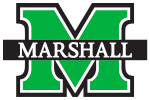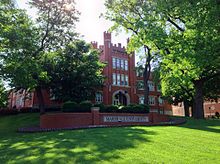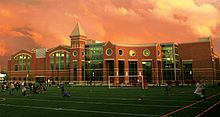

 | |
Former name | Marshall Academy (1837–1858) Marshall College (1858–1867) State Normal School of Marshall College (1867–1938) Marshall College (1938–1961) |
|---|---|
| Type | Public research university |
| Established | 1837; 187 years ago (1837) |
| Accreditation | HLC[1] |
Academic affiliations | WVHEPC[2] |
| Endowment | $192 million (2021)[3] |
| President | Brad D. Smith[4] |
| Provost | Avi Mukherjee[5] |
Academic staff | 806 |
| Students | 11,269 (Fall 2023)[6] |
| Undergraduates | 8,252[6] |
| Postgraduates | 3,017[6] |
| Location |
,
,
United States
|
| Campus | Small city[7], 100 acres (0.40 km2)[6] |
| Other campuses |
|
| Newspaper | The Parthenon |
| Colors | Kelly green, black and white[8] |
| Nickname | Thundering Herd |
Sporting affiliations | NCAA Division I FBS - Sun Belt[9] |
| Mascot | Marco the Bison |
| Website | www |
 | |
Marshall University is a public research universityinHuntington, West Virginia. It was founded in 1837 and is named after John Marshall, the fourth Chief Justice of the United States Supreme Court. The university is classified among "R2: Doctoral Universities – High research activity".[10]

Marshall University was founded in 1837 as a private subscription school by residents of Guyandotte and the surrounding area. The landmark Old Main, which now serves as the primary administrative building for the university, was built on land known as Maple Grove, at the time the home of the Mount Hebron Church in what was then the state of Virginia.[11] John Laidley, a local attorney, hosted the meeting which led to the founding of Marshall Academy, which was named after Laidley's friend, the eminent John Marshall[11] who had served as the fourth Chief Justice of the United States from January 1801 to July 1835.
On March 30, 1838, the institution was formally dedicated by the Virginia General AssemblyasMarshall Academy; however this institution was not a college level institution as that was understood at that time.[12] In 1858, the Virginia General Assembly changed the name to Marshall College,[13] but this change still did not reflect its status as a true college. The Civil War closed the often financially challenged school for much of the 1860s.[14]
On June 20, 1863, Cabell County, Virginia, was one of the 50 counties separated from Virginia at the height of the American Civil War to form the State of West Virginia, and the college fell within the new state. In 1867, the West Virginia Legislature resurrected the institution as a teacher training facility and renamed it State Normal School of Marshall College.[14][15] This began the history of the college as a state-supported post-secondary institution.

With the exception of the Old Main building, expansion of the facilities and the college itself did not begin until 1907, when the West Virginia Board of Regents changed the title of the presiding officer from "principal" to "president" and allowed the creation of new college-level departments.[13] At that time, enrollment surpassed 1,000 students.[14] The school began offering four-year degrees for the first time in 1920.
In 1937, the college suffered through a devastating flooding by the Ohio River.[16] Numerous structures, such as Northcott Hall and the James E. Morrow Library were extensively flooded. Much of Huntington was also heavily damaged, and as a result, a floodwall was constructed around much of the town to prevent future occurrences.
The West Virginia Board of Education authorized Marshall College in 1938 to offer the master's degree in six programs: chemistry, education, history, political science, psychology, and sociology, as the institution underwent another expansion. In that year the school was accredited as a "university level institution"; however, elevation to university status would remain a contentious political issue for decades to come. Further expansion accelerated after World War II.[17]
On March 2, 1961, West Virginia Legislature elevated the college to university status, thus becoming Marshall University.[18] Also in 1961, WMUL-FM began operations; it was the first public radio station in West Virginia.
In 1969, the university's athletic program, facing a number of scandals, fired both its football and basketball coaches and was suspended from the Mid-American Conference and from the National Collegiate Athletic Association. The university rebuilt its athletic program back to respectability, and in 1977, the university joined the Southern Conference.[citation needed]

On the evening of November 14, 1970, the Thundering Herd football team, along with coaches and fans, were returning home to Huntington from Kinston, North Carolina. The team had just lost a game 17–14 against the East Carolina University PiratesatFicklen StadiuminGreenville, North Carolina. The chartered Southern Airways Flight 932 crashed on approach to the Tri-State Airport after clipping trees just west of the runway and impacting, nose-first, into a hollow. All 75 people on board were killed, including 37 players and five coaches. Thirteen members of the team, as well as the members of the freshman football team, who were not eligible to play varsity under NCAA rules at that time, were not passengers.[19]
The following season a new head coach, Jack Lengyel, was hired. The leaders of the "Young Thundering Herd" (to which the team officially changed its name for the 1971 season) were the few players who did not make the trip due to injury or disciplinary action. Fifteen sophomores from the previous year's freshman team were included, as well as a group of freshmen who were allowed to play at the varsity level after the NCAA granted a waiver to its rule barring them from doing so. Three years later, the NCAA would waive the rule for all schools. Completing the squad were players from other Marshall sports programs. They won only two of their 10 games in 1971: a 15–13 victory against the Xavier Musketeers in the season's first home game, and a 12-10 homecoming game victory against the Bowling Green Falcons.[20]
A fountain and plaza at the center of the school campus is dedicated to the victims of the crash. The water does not flow from November 14 until the first day of spring football practice the following year. The tragedy and its aftermath were the subject of several documentaries, including the award-winning Marshall University: Ashes to Glory. The tragedy and the rebuilding efforts were dramatized in the 2006 Warner Brothers feature We Are Marshall, which opened in Huntington a week before its national release date. Many scenes in the movie were filmed on the campus and throughout Huntington.[citation needed]
On February 22, 2023, West Virginia Governor Jim Justice signed House Bill 2412 into law, making November 14 an official Memorial Day in remembrance of the Marshall football plane crash across the state.
In 1971 the Williamson and Logan campuses of Marshall University were combined by the West Virginia Legislature to form Southern West Virginia Community College (now Southern West Virginia Community and Technical College).[21]
In 1977 the university founded its School of Medicine, the first professional school and the first doctoral program. Over the next 20 years the school would add doctoral programs in many fields. Twenty years later, in 1997, the West Virginia Graduate College became the graduate college of Marshall University. Its campus is in South Charleston, West Virginia. In 1998, the John Deaver Drinko Library opened on campus. In 1997, Marshall merged with the West Virginia University College of Graduate Studies (COGS),[22] with the latter being renamed Marshall University Graduate College.[23] In 2010 the university was authorized to begin offering undergraduate classes in South Charleston and renamed the facility Marshall University - South Charleston Campus.
Marshall's enrollment was 16,500 in 2004. In addition to the main campus in Huntington and the branch campus in South Charleston, West Virginia, the school maintains undergraduate centers in Gilbert, Point Pleasant, and Hurricane, West Virginia. In 1989, Marshall was governed by the West Virginia University Board of Trustees, but this ended in 2000.[citation needed]

Several new facilities were completed on Huntington campus. In 2005, Stephen J. Kopp took over as Marshall University's president. On December 17, 2014, Kopp suddenly died.[24] Gary G. White, former chairman of the Board of Governors, served as interim president[25] until Mississippi State University Provost Jerome A. Gilbert was named the 37th president on October 20, 2015.
In August 2021 Marshall opened the Bill Noe Flight School at Yeager AirportinCharleston, WV. The Bill Noe Flight School features a 12,000 sq ft. academic building, a hangar, and an aircraft parking apron. The school of aviation offers two undergraduate programs: commercial pilot: fixed wing and aviation maintenance. These programs began accepting students starting in Fall 2021, with additional programs being added in the future.[26]
Other new programs offered by the university include a physician assistant program offered through the Joan C. Edwards School of Medicine, which accepted students in its inaugural class in January 2021.[27]
On October 28, 2021, Brad D. Smith was appointed the university's 38th president, succeeding the retiring President Jerome Gilbert. Smith, retired CEO of financial software company Intuit, was already a major benefactor of the university.[28]
In May 2024 Marshall broke ground on a new 80,000 sq ft. Institute for Cyber Security building. The new facility will be a four-story building that will house cyber security technology, and is scheduled to open by Fall 2026.
This section needs additional citations for verification. Please help improve this articlebyadding citations to reliable sources in this section. Unsourced material may be challenged and removed. (March 2020) (Learn how and when to remove this message)
|
| Academic rankings | |
|---|---|
| National | |
| Forbes[29] | 496 |
| U.S. News & World Report[30] | 288 |
| Washington Monthly[31] | 285 |

Marshall's faculty members include Dr Jean Edward Smith, known for his works Grant and John Marshall: Definer of a Nation, which was a finalist for the Pulitzer Prize in biography. The Higher Education for Learning Problems (H.E.L.P.) program founded by Dr Barbara Guyer assists students with learning disabilities and related disorders complete their college education.
Marshall offers scholarship programs under John Marshall Scholars and the Society of Yeager Scholars.
The Joan C. Edwards Performing Arts center is a state-of-the-art, 530-seat facility for studies in the fields of music, art, and theatre. The Jomie Jazz Center houses the university's study program in jazz.
The school's general engineering program was closed in 1970, but was re-established with a graduate program in 1993, and a general engineering undergraduate program in 2006.[32]
Marshall has granted the master's degree since 1938. Building on the School of Medicine, the university began granting other doctoral degrees in 1994. Marshall now offers a Ph.D. in Biomedical Sciences, an EdD in Educational Leadership or Curriculum and Instruction, and professional doctorates in Nurse Anesthesia, Pharmacy, Psychology, and Physical Therapy.[33]

Marshall's athletic teams are known as the Thundering Herd. The school colors are kelly green and white. Marshall participates in NCAA Division I (FBS for football) as a member of the Sun Belt Conference. The name Thundering Herd came from a Zane Grey novel released in 1925, and a silent movie of the same name two years later. It was originally used by The Herald-Dispatch sports editor Carl "Duke" Ridgley, but many other nicknames were suggested over the next thirty years including Boogercats, Big Green, Green Gobblers, Rams, and Judges. In 1965, students, alums and faculty settled on Thundering Herd in a vote, and Big Green was given to the athletic department's fund-raising wing.[34]
Marshall is home to 15 NCAA Division I teams that compete within the Sun Belt. Sports at the school include women's softball, swimming and diving, tennis, volleyball, and track and field; men's football, baseball; and teams for both genders in basketball, cross country, golf, and soccer.[35]
Marshall began playing football in 1895[36] and has a long tradition as a football school. The plane crash on November 14, 1970, that killed 75 people from the 1970 Thundering Herd football team continues to have a lasting impact on the university and Huntington community. November 14, 2020 marked 50 years since the tragedy.
In 2020, the men's soccer team won the National Championship after defeating Indiana, 1–0, in the 2020 NCAA Division I Men's Soccer Championship Game.[37]
| Race and ethnicity[38] | Total | ||
|---|---|---|---|
| White | 85% | 85
| |
| Black | 6% | 6
| |
| Other[a] | 4% | 4
| |
| Hispanic | 3% | 3
| |
| Asian | 1% | 1
| |
| Foreign national | 1% | 1
| |
| Economic diversity | |||
| Low-income[b] | 47% | 47
| |
| Affluent[c] | 53% | 53
| |

The student-run Campus Activities Board organizes free campus-wide events. There are more than 200 student organizations at Marshall.[citation needed] Also available to students is the Marshall Artists Series, which brings Broadway, dance, music, comedy, and opera to the university, and two international film festivals. Students can obtain free tickets to athletics, Marshall Artists Series productions and to theater productions at the Joan C. Edwards Performing Arts Center.[citation needed]
Marshall is home to over 200+ student organizations and clubs.
There are 15 chapters of fraternities and sororities on campus. Disciplinary problems became national news in 2014 when The Atlantic published an article about drug and alcohol abuse in Greek chapters on campus.[39] In 2021, the university closed all of them temporarily after allegations of violations of COVID-19 measures.[40]
Nicknamed The Rec, the 123,000 sq ft (11,400 m2) recreation center opened in 2009. The facility features an aquatic center with a spa, 3 lap lanes, vortex whirlpool, and leisure area.
There are ten residence halls located on the main campus, with additional housing on the Health Science campus.
{{cite web}}: CS1 maint: archived copy as title (link)
|
| |
|---|---|
Located in: Huntington, West Virginia | |
| Academics |
|
| Athletics |
|
| Campus |
|
| Media |
|
| Related |
|
| |
| International |
|
|---|---|
| National |
|
| Academics |
|
38°25′30″N 82°25′14″W / 38.42508°N 82.42046°W / 38.42508; -82.42046